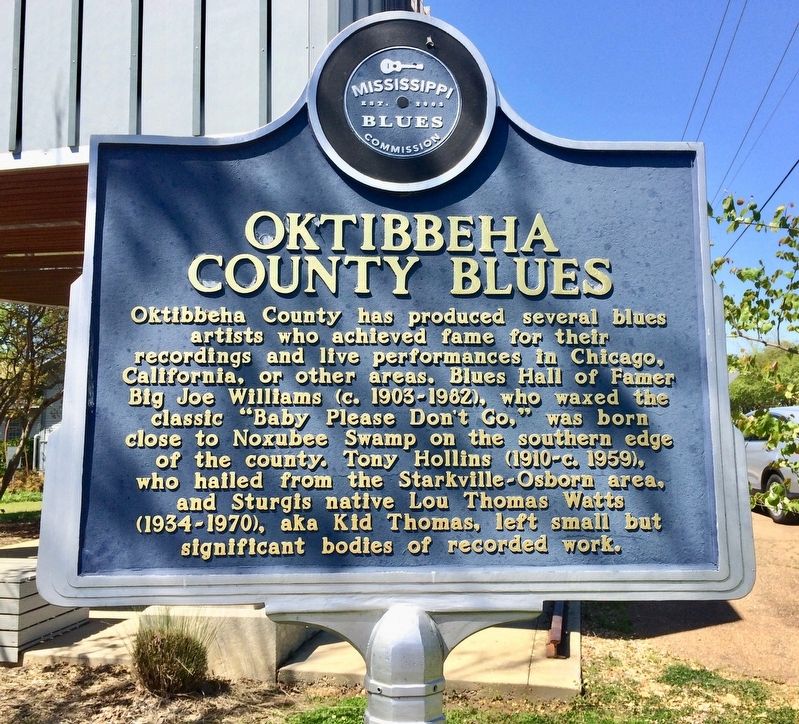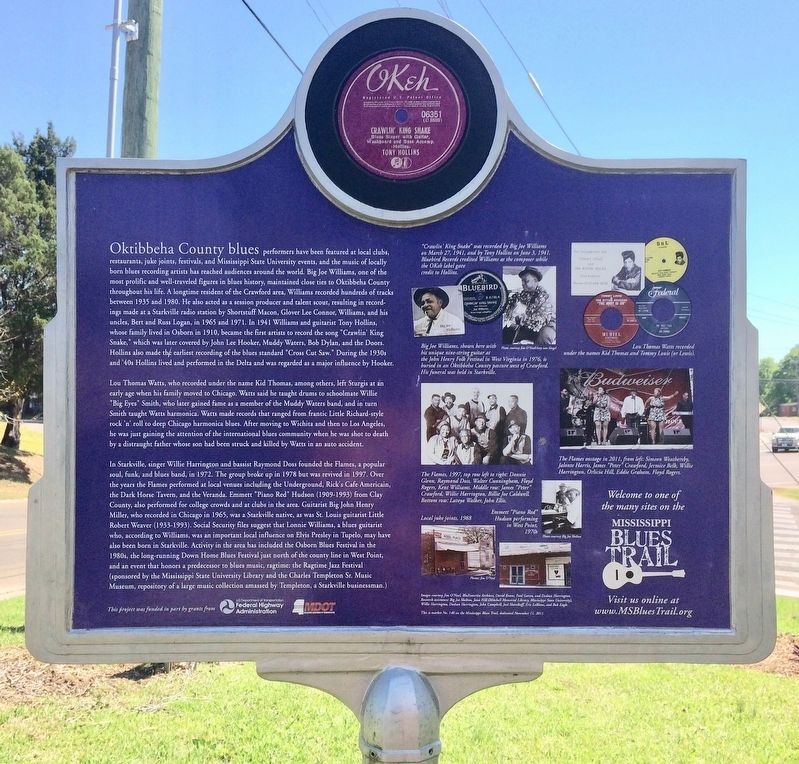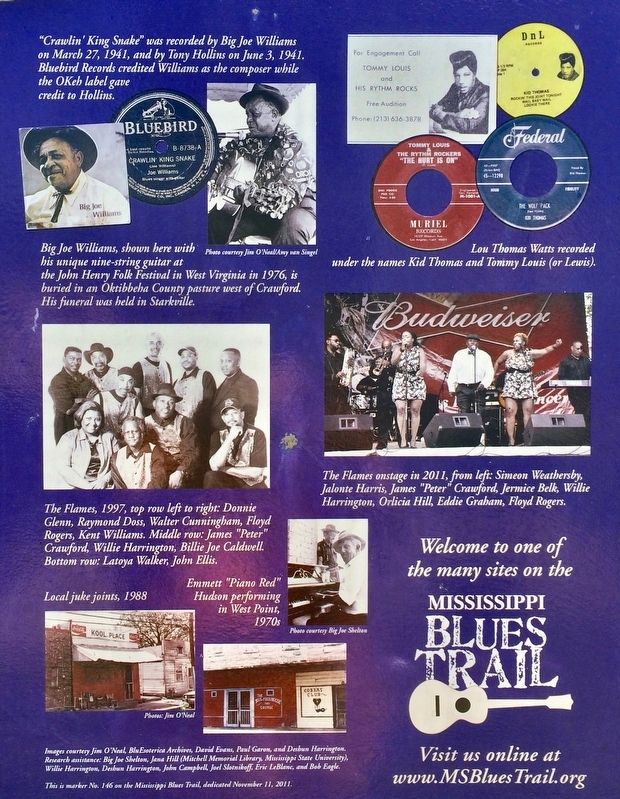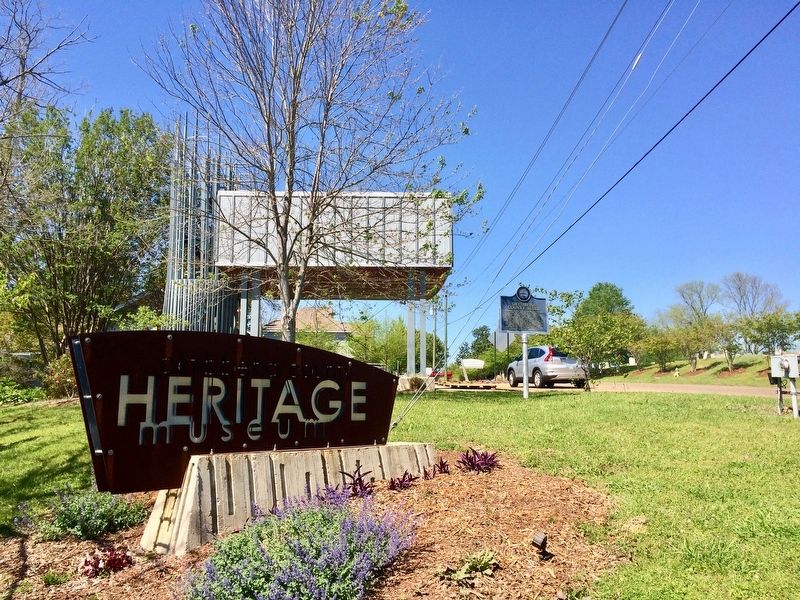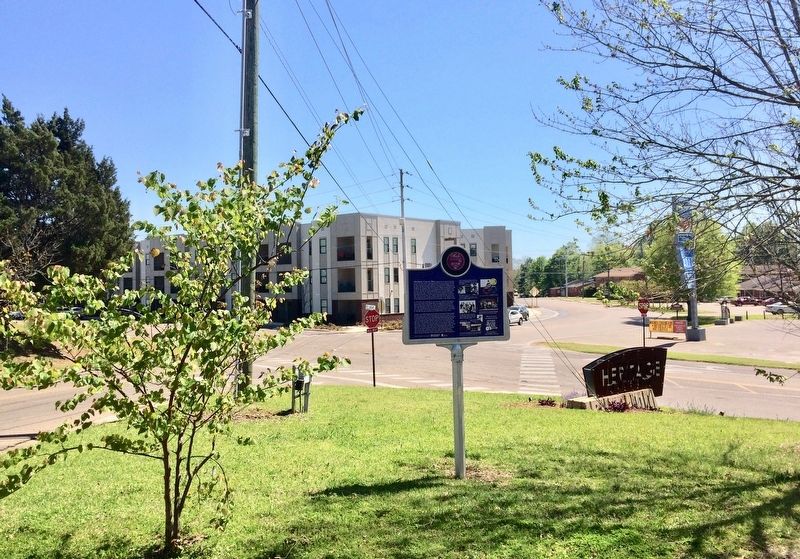Starkville in Oktibbeha County, Mississippi — The American South (East South Central)
Oktibbeha County Blues
Front
Oktibbeha County has produced several blues artists who achieved fame for their recordings and live performances in Chicago, California, or other areas. Blues Hall of Famer Big Joe Williams (c. 1903-1982), who waxed the classic "Baby Please Don't Go," was born close to Noxubee Swamp on the southern edge of the county. Tony Hollins (1910-c. 1959), who hailed from the Starkville-Osborn area, and Sturgis native Lou Thomas Watts (1934-1970), aka Kid Thomas, left small but significant bodies of recorded work.
Rear
Oktibbeha County blues performers have been featured at local clubs, restaurants, juke joints, festivals, and Mississippi State University events, and the music of locally born blues recording artists has reached audiences around the world. Big Joe Williams, one of the most prolific and well-traveled figures in blues history, maintained close ties to Oktibbeha County throughout his life. A longtime resident of the Crawford area, Williams recorded hundreds of tracks between 1935 and 1980. He also acted as a session producer and talent scout, resulting in recordings made at a Starkville radio station by Shortstuff Macon, Glover Lee Connor, Williams, and his uncles, Bert and Russ Logan, in 1965 and 1971. In 1941 Williams and guitarist Tony Hollins, whose family lived in Osborn in 1910, became the first artists to record the song "Crawlin' King Snake," which was later covered by John Lee Hooker, Muddy Waters, Bob Dylan, and the Doors. Hollins also made the earliest recording of the blues standard "Cross Cut Saw." During the 1930s and '40s Hollins lived and performed in the Delta and was regarded as a major influence by Hooker.
Lou Thomas Watts, who recorded under the name Kid Thomas, among others, left Sturgis at an early age when his family moved to Chicago. Watts said he taught drums to schoolmate Willie "Big Eyes" Smith, who later gained fame as a member of the Muddy Waters band, and in turn Smith taught Watts harmonica. Watts made records that ranged from frantic Little Richard-style rock 'n' roll to deep Chicago harmonica blues. After moving to Wichita and then to Los Angeles, he was just gaining the attention of the international blues community when he was shot to death by a distraught father whose son had been struck and killed by Watts in an auto accident.
In Starkville, singer Willie Harrington and bassist Raymond Doss founded the Flames, a popular soul, funk, and blues band, in 1972. The group broke up in 1978 but was revived in 1997. Over the years the Flames performed at local venues including the Underground, Rick's Cafe Americain, the Dark Horse Tavern, and the Veranda. Emmett "Piano Red" Hudson (1909-1993) from Clay County, also performed for college crowds and at clubs in the area. Guitarist Big John Henry Miller, who recorded in Chicago in 1965, was a Starkville native, as was St. Louis guitarist Little Robert Weaver (1933-1993). Social Security files suggest that Lonnie Williams, a blues guitarist who, according to Williams, was an important local influence on Elvis Presley in Tupelo, may have also been born in Starkville. Activity in the area has included the Osborn Blues Festival in the 1980s, the long-running Down Home Blues Festival just north of the county line in West Point, and an event that honors a predecessor to blues music, ragtime: the Ragtime Jazz Festival (sponsored by the Mississippi State University Library and the Charles Templeton Sr. Music Museum, repository of a large music collection amassed by Templeton, a Starkville businessman.)
Erected 2011 by the Mississippi Blues Commission. (Marker Number 146.)
Topics and series. This historical marker is listed in these topic lists: African Americans • Arts, Letters, Music • Entertainment. In addition, it is included in the Mississippi Blues Trail series list. A significant historical year for this entry is 1935.
Location. 33° 27.587′ N, 88° 48.435′ W. Marker is in Starkville, Mississippi, in Oktibbeha County. Marker is at the intersection of Fellowship Street and Russell Street, on the right when traveling south on Fellowship Street. Touch for map. Marker is at or near this postal address: 206 Fellowship Street, Starkville MS 39759, United States of America. Touch for directions.
Other nearby markers. At least 8 other markers are within walking distance of this marker. Needmore Community (approx. 0.2 miles away); Nash Street Historic District (approx. ¼ mile away); The Borden Milk Plant (approx. ¼ mile away); Overstreet School District (approx. 0.4 miles away); First Presbyterian Church (approx. 0.4 miles away); Starkville (approx. half a mile away); First Baptist Church (approx. half a mile away); Oktibbeha Gardens (approx. 0.6 miles away). Touch for a list and map of all markers in Starkville.
Credits. This page was last revised on April 17, 2017. It was originally submitted on April 17, 2017, by Mark Hilton of Montgomery, Alabama. This page has been viewed 267 times since then and 23 times this year. Photos: 1, 2, 3, 4, 5. submitted on April 17, 2017, by Mark Hilton of Montgomery, Alabama.
